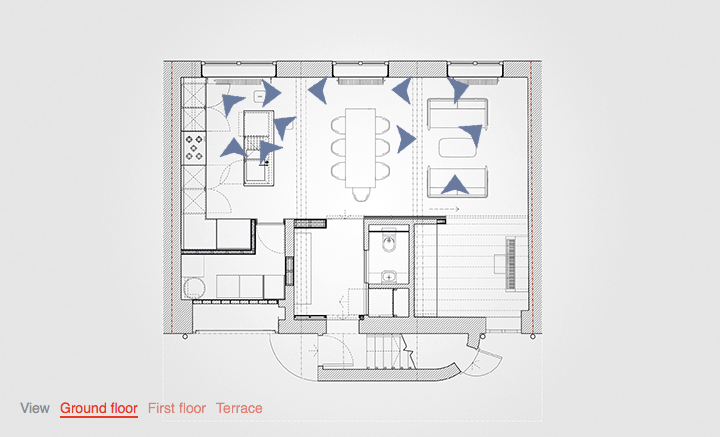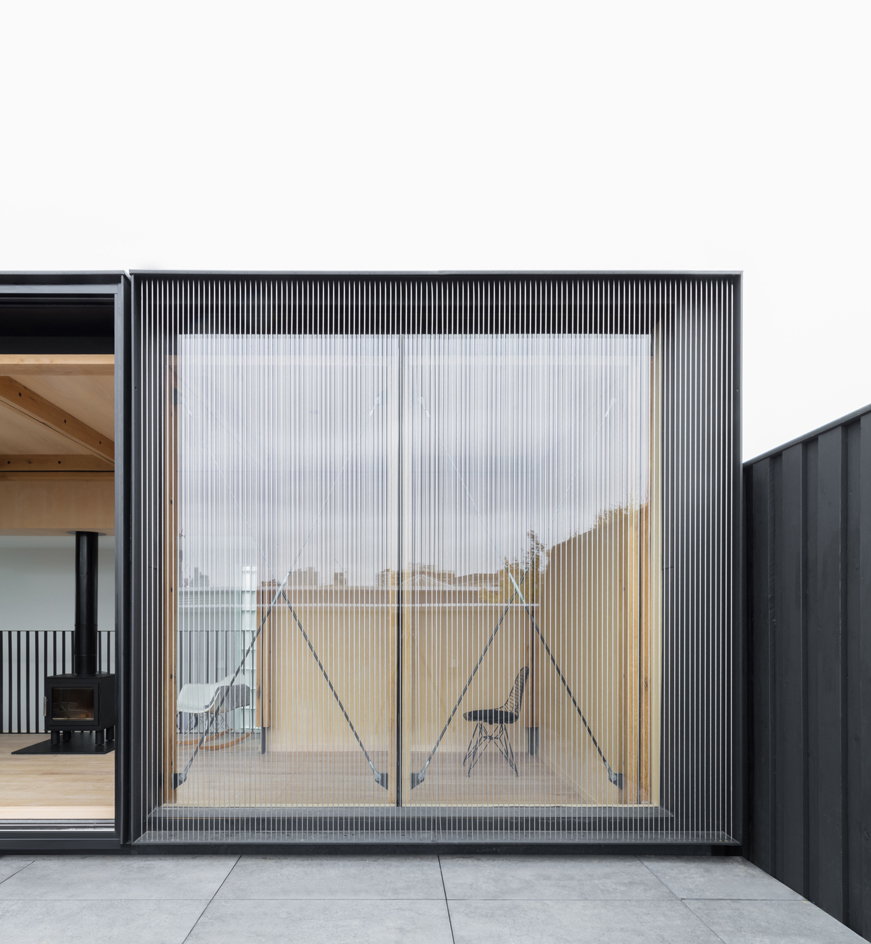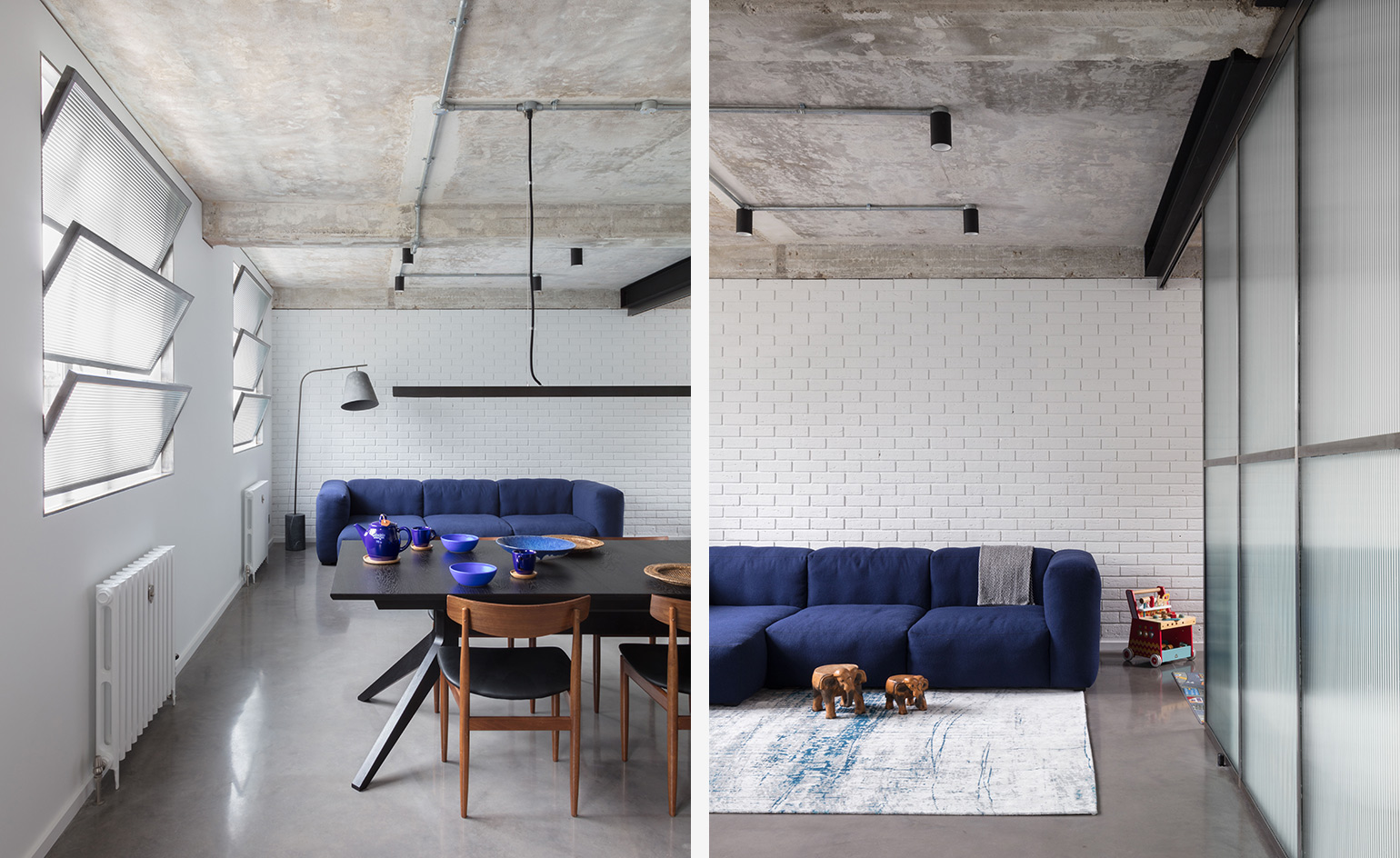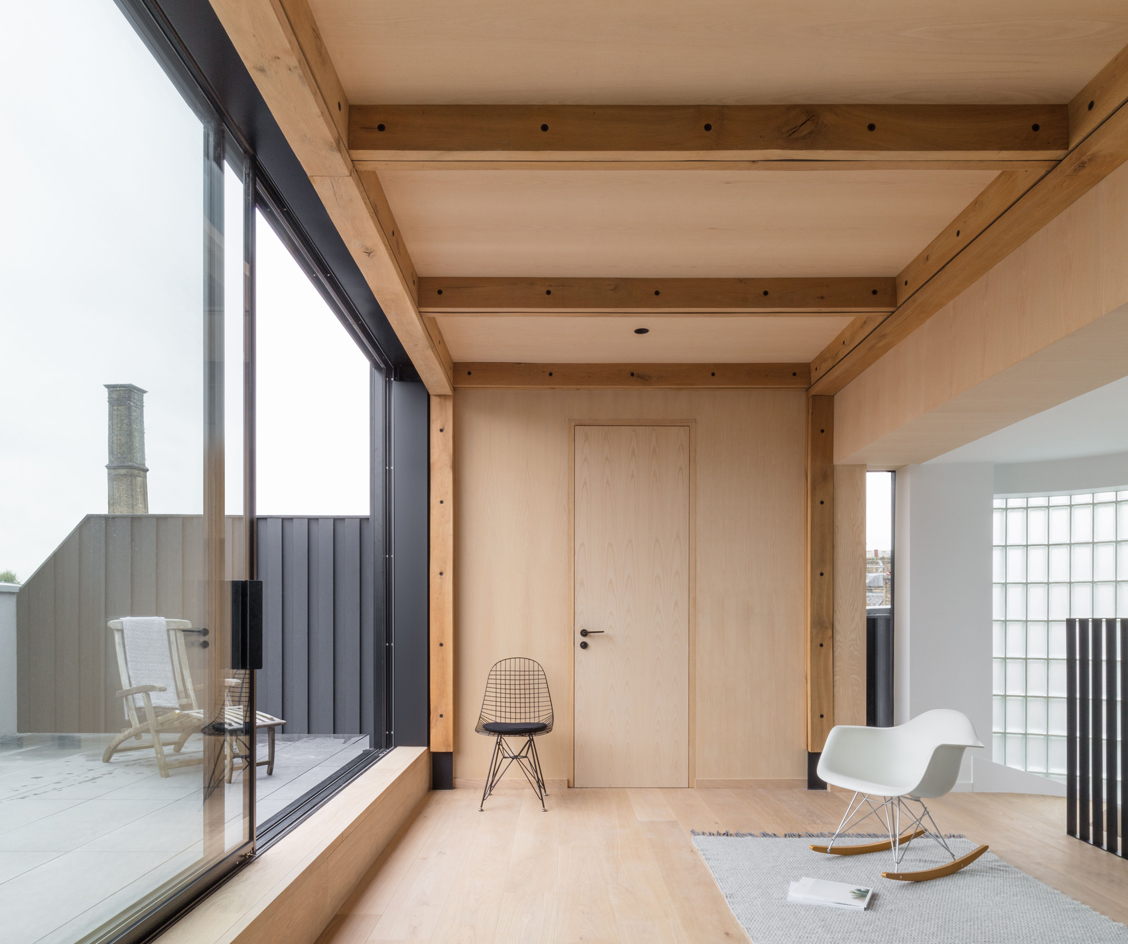Nicholas Szczepaniak reinvents a London canal-side residential conversion

A drab canal-side house converted from a factory has been reinvented with sleek new interiors and a one-off roof extension. The 1990s house, Union Wharf, sits on the Regents Canal in London’s Islington. It had been fashioned out of a post-war factory, and suffered from cellular rooms, timber laminate flooring and a roof-top conservatory that leaked heat.
The most striking change made by Nicholas Szczepaniak Architects is the replacement of that energy-inefficient top room. In its place is a steel and timber pod with visible cross-bracing on one side, which was devised with the help of structural engineers, Blue. The smart new space has a small en-suite, so that it doubles as a guest room and study. Steel cables are strung vertically in front of some of the glazing, to diffuse the direct sunlight. Light comes into the stairwell via glass bricks and a porthole, which references the boats below.

Take an interactive tour of Union Wharf House
On the ground floor, the problem was a lack of character and good usable space. Szczepaniak moved the kitchen into the converted garage and took a wall down, so that the kitchen is connected to the dining area. The previous kitchen has been turned into a playroom for the client’s young family, which can be cordoned off by a 2m by 2m fluted glass sliding door.
More lovely fluted glass has been used in the kitchen, for the specially-made rotating window shutters. ‘They were borne out of real issue, because the house is directly on the canal towpath,’ explains Szczepaniak. ‘Previously the owners had to have ugly metal shutters and a black-out blind to stop people looking in.’
With the enlarged roof-extension and clever reconfiguring on other floors, this three-storey house has gone from being 150 sq m and tired to 163 sq m and highly-functional.

The architects replaced an existing energy-inefficient room at the top with a minimalist steel and timber pod. Photography: Nicholas Worley

The smart new space has a small en-suite, so that it doubles as a guest room and study, while it opens up onto a terrace. Photography: Nicholas Worley

Fluted glass has been used in the kitchen, for the specially-made rotating window shutters. Photography: Nicholas Worley

Szczepaniak moved the kitchen into the converted garage and took a wall down, to unite kitchen and dining area. Photography: Nicholas Worley

Szczepaniak's design transformed the tired, existing house, while adding 13sqm in the process. Photography: Nicholas Worley

The rooftop space is flooded with light, which comes into the stairwell via glass bricks and a porthole. Photography: Nicholas Worley

The addition features visible cross-bracing on one side, which was devised with the help of structural engineers, Blue. Photography: Nicholas Worley
INFORMATION
For more information, visit the Nicholas Szczepaniak Architects website
Receive our daily digest of inspiration, escapism and design stories from around the world direct to your inbox.
Clare Dowdy is a London-based freelance design and architecture journalist who has written for titles including Wallpaper*, BBC, Monocle and the Financial Times. She’s the author of ‘Made In London: From Workshops to Factories’ and co-author of ‘Made in Ibiza: A Journey into the Creative Heart of the White Island’.
-
 How Charles and Ray Eames combined problem solving with humour and playfulness to create some of the most enduring furniture designs of modern times
How Charles and Ray Eames combined problem solving with humour and playfulness to create some of the most enduring furniture designs of modern timesEverything you need to know about Charles and Ray Eames, the American design giants who revolutionised the concept of design for everyday life with humour and integrity
-
 Why are the most memorable watch designers increasingly from outside the industry?
Why are the most memorable watch designers increasingly from outside the industry?Many of the most striking and influential watches of the 21st century have been designed by those outside of the industry’s mainstream. Is it only through the hiring of external designers that watch aesthetics really move on?
-
 This Fukasawa house is a contemporary take on the traditional wooden architecture of Japan
This Fukasawa house is a contemporary take on the traditional wooden architecture of JapanDesigned by MIDW, a house nestled in the south-west Tokyo district features contrasting spaces united by the calming rhythm of structural timber beams
-
 Arbour House is a north London home that lies low but punches high
Arbour House is a north London home that lies low but punches highArbour House by Andrei Saltykov is a low-lying Crouch End home with a striking roof structure that sets it apart
-
 A former agricultural building is transformed into a minimal rural home by Bindloss Dawes
A former agricultural building is transformed into a minimal rural home by Bindloss DawesZero-carbon design meets adaptive re-use in the Tractor Shed, a stripped-back house in a country village by Somerset architects Bindloss Dawes
-
 RIBA House of the Year 2025 is a ‘rare mixture of sensitivity and boldness’
RIBA House of the Year 2025 is a ‘rare mixture of sensitivity and boldness’Topping the list of seven shortlisted homes, Izat Arundell’s Hebridean self-build – named Caochan na Creige – is announced as the RIBA House of the Year 2025
-
 In addition to brutalist buildings, Alison Smithson designed some of the most creative Christmas cards we've seen
In addition to brutalist buildings, Alison Smithson designed some of the most creative Christmas cards we've seenThe architect’s collection of season’s greetings is on show at the Roca London Gallery, just in time for the holidays
-
 In South Wales, a remote coastal farmhouse flaunts its modern revamp, primed for hosting
In South Wales, a remote coastal farmhouse flaunts its modern revamp, primed for hostingA farmhouse perched on the Gower Peninsula, Delfyd Farm reveals its ground-floor refresh by architecture studio Rural Office, which created a cosy home with breathtaking views
-
 A revived public space in Aberdeen is named Scotland’s building of the year
A revived public space in Aberdeen is named Scotland’s building of the yearAberdeen's Union Terrace Gardens by Stallan-Brand Architecture + Design and LDA Design wins the 2025 Andrew Doolan Best Building in Scotland Award
-
 The Architecture Edit: Wallpaper’s houses of the month
The Architecture Edit: Wallpaper’s houses of the monthFrom wineries-turned-music studios to fire-resistant holiday homes, these are the properties that have most impressed the Wallpaper* editors this month
-
 A refreshed 1950s apartment in East London allows for moments of discovery
A refreshed 1950s apartment in East London allows for moments of discoveryWith this 1950s apartment redesign, London-based architects Studio Naama wanted to create a residence which reflects the fun and individual nature of the clients